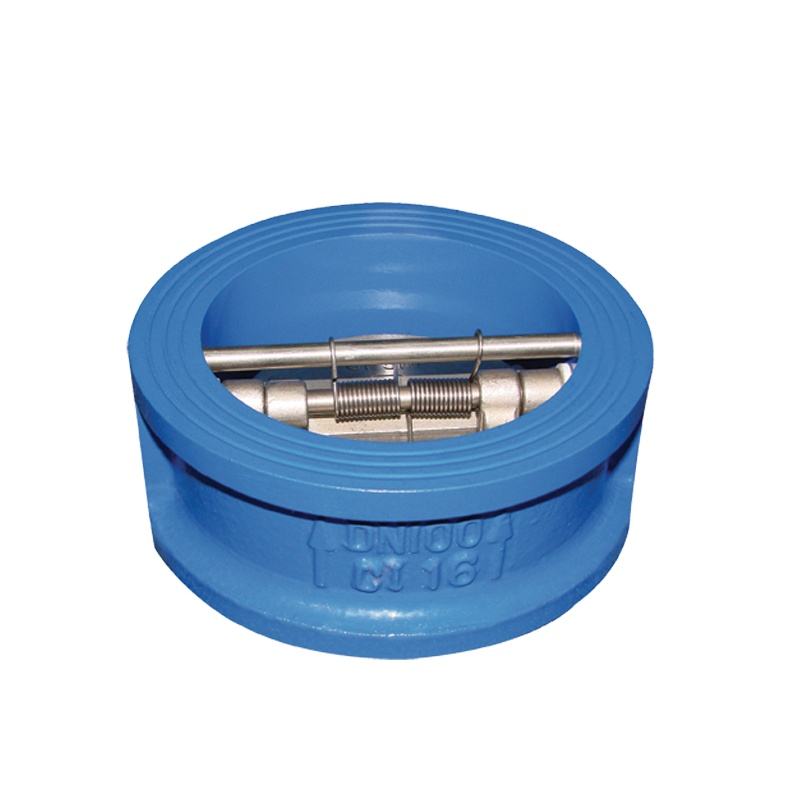A dual plate check valve is a type of mechanical valve that prevents backflow and ensures the flow of fluid in one direction. This article explores the design, working principles, and applications of the dual plate check valve, providing a comprehensive overview for anyone seeking to learn more about this important piece of engineering technology.
Dual Plate Check Valves, also known as Check Valves with two plates and two plugs, are used to regulate the flow of liquid, gas, and steam in HVAC/R systems as well as water supply lines, oil/natural gas pipelines, and steam and condensate systems.
These valves are lightweight, slim, and easy to install. Their hydrodynamic properties and pressure loss losses are exceptional, while there is a variety of end connection types to choose from.
A check valve is a mechanical device that opens and closes automatically depending on whether fluid flows in one direction or reverse flow, protecting mechanical components in pipe systems from backflow damage.
There are two primary types of check valves, swing, and dual plate.Swing check valve open and shut based on fluid movement, whereas dual plate check valves only open when forward flow occurs and close when reverse flows take place.
Check valves are essential components in systems designed to prevent water from flowing back and forth between containers, which helps avoid floods and other complications.
There are various types of dual plate check valves, including reduce-flow, non-slam, and retainer-less models. All have their own set of advantages and disadvantages.
Reduced-Flow Check Valves are non-return valves used in numerous industries and applications, allowing fluid to pass in one direction while blocking its return path. They’re commonly known for allowing flow in one direction but preventing reverse flow from taking place.
Check valves come in various sizes and from numerous manufacturers; when choosing one for your application, make sure it comes from a reputable provider.
Non-Slam Check Valves are spring-assisted valves used to prevent the backflow of liquids. When the inlet pressure exceeds that of downstream pressure, this valve opens, but as soon as reverse pressure builds up again, it closes again to ensure no backflow occurs.
Valves come in various designs and can be installed into pipe systems to control the flow of fluids like water, air, or steam.
Retainerless check valves feature no holes that pass through their bodies, enabling installation without drilling all the way through a pipe. This feature makes these check valves particularly beneficial in applications involving potentially harmful or corrosive gases passing through them.
Retainerless check valves also referred to as lug-type check valves, can be connected directly to pipe flanges using bolts according to API 594 for direct mounting.
Wafer check valve (or dual plate check valves) are ideal for applications where space is at a premium, thanks to their slim design that fits between flanges without needing gaskets.
These check valves are specifically tailored for water supply, chemical, pharmaceutical, food and beverage production applications, mining operations, steam power generation plants, and oil and gas industries, among many others. Available in various styles and sizes to meet various requirements.
Dual plate check valves are widely used in various industries for controlling the flow of fluids and preventing backflow. Some common applications of dual plate check valves include:
Dual plate check valves boast numerous advantages and features that can benefit businesses, such as non-slam design, low-pressure drop, and increased capacity.
Wafer-type valves are lightweight alternatives to swing check valves and boast excellent hydrodynamic properties, making them suitable for liquid, gas, and steam applications.
Dual plate check valves use two spring-loaded plates hinged on a central hinge pin to reduce flow resistance when required. Employing torsion spring action without reverse flow, these plates close quickly without water hammer action – making it one of the most efficient designs in the industry.
Dual-plate check valves feature a lower slam rate compared to swing valves, helping reduce noise production. Furthermore, water hammering incidents, which could otherwise cause system surges and joint leakage issues, are reduced significantly with these dual-plate check valves.
Dual plate check valves offer numerous advantages and features that make them suitable solutions for various industrial applications.
Its non-slam design helps prevent water hammering in pipeline systems while simultaneously lowering pressure drops and energy losses.
Dual Plate Check Valves consist of two semi-discs hinged around a central pin that opens when upstream pressure exceeds downstream pressure, closing when flow velocity decreases, thus decreasing flow resistance without reverse flow requirement, thus avoiding system surges and water hammer.
Dual plate check valves are versatile solutions that are suitable for many liquid, gas, and steam operations, including heating, air conditioning, and compressed air systems. Their low-pressure drop, lightweight design, and easy installation make them a popular choice among engineers.
Dual Plate Check Valves are non-return valves used to prevent media from flowing backward in pipelines. They’re commonly found across a variety of industries that deal with liquids, gases, or steam applications.
The dual plate check valve features a wafer structure and lightweight design, making it easier to handle and install. Furthermore, its compact size and excellent hydrodynamic properties help minimize pressure losses.
Dual Plate Check Valves are non-return valves with several advantages over their competitors. Their low energy consumption, non-slam design, and ability to withstand industrial applications make them ideal for industrial settings.
Light and compact designs make these devices easy to handle, enabling installation between pipe flanges without needing additional support or an extension rod.
